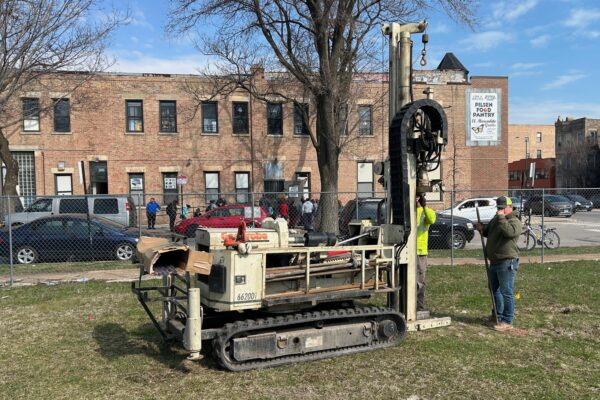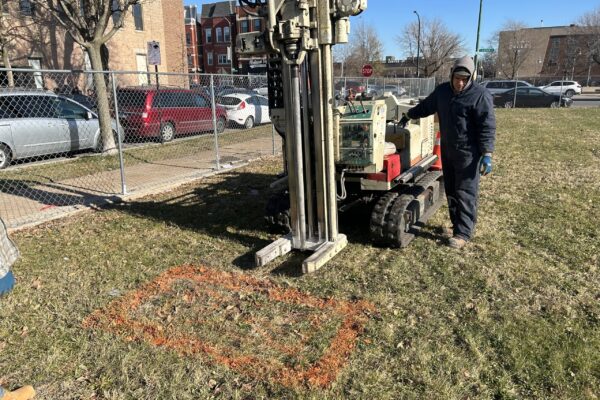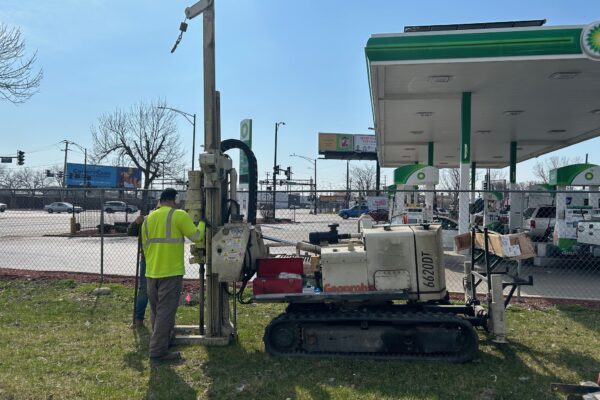Client: The Resurrection Project | Location: Chicago, Illinois
Pioneer was contracted to assist with the residential redevelopment of a former industrial property in Chicago. A Phase I ESA that Pioneer prepared for this site revealed the property was used for various commercial and industrial purposes from at least 1914 to 2015, with historical industrial occupants including an automobile repair shop, iron works facility, blacksmith, machine shop, and manufacturing/welding shop; re-coopering activities were also performed at the site circa 1950.
Pioneer subsequently conducted Phase II Site Investigations, including the performance of a ground penetrating radar (GPR) survey, to determine if the site had been impacted by the historical industrial operations and assess for the presence of “orphan” underground storage tanks (USTs). The GPR survey confirmed the presence of one UST at the site, and the results of the Phase II investigations identified elevated levels of certain metals (arsenic, lead and mercury), polynuclear aromatic hydrocarbons, and polychlorinated biphenyls (PCBs) in the site’s soil, as well as iron and lead in the site’s groundwater. Of note, mercury was identified above the soil saturation limit and total petroleum hydrocarbon (TPH) was identified above the soil attenuation capacity.
Based on the cumulative subsurface investigation results, Pioneer conducted an endangerment assessment and developed a remedial action plan designed to secure a comprehensive, residential land use No Further Remediation (NFR) letter from the Illinois Environmental Protection Agency’s (EPA’s) Site Remediation Program. Pioneer also developed a separate remedial action plan to address the identified PCB concentrations in accordance with US EPA regulatory requirements.
Full implementation of the remedial action plan will include removal of the UST and “hot spot” remediation to achieve the soil saturation limit and soil attenuation capacity. Residual contaminants will then be capped with engineered barriers, and managed in-place through the use of preventive and institutional controls.
In 2021, Pioneer was also contracted to perform a comprehensive geotechnical investigation for a proposed 8-story residential building at this property, and Pioneer was then recontacted in 2023 to perform a supplemental investigation for this project, both in compliance with OUC (Office of Underground Coordination) requirements. The geotechnical subsurface investigation consisted of drilling using hollow stem augers and rotary mud drilling techniques, as well as rock core sampling in the underlying dolomitic bedrock. The site soils consisted of up to nearly 10 feet of typical Chicago urban fill, underlain by a layer of Chicago “blue clay”, followed by a thin deposit of “hardpan” above the Dolomitic Limestone bedrock at a depth of 35 feet below the existing grade.
As part of the original and supplemental investigations, Pioneer performed field vane shear tests in the soft, cohesive “blue clay” to assist in caisson design. On the rock core samples recovered, Pioneer also completed a Rock Quality Determination (RQD) to evaluate the potential suitability of end-bearing caissons on the bedrock surface. Poor bedrock conditions encountered in the rock cores eliminated the option of having the caissons bearing on or tied into the bedrock.
Based on an advanced in-situ testing in the field, laboratory data, and engineering analyses, in conjunction with the anticipated high maximum column loads, Pioneer assisted the architectural and structural teams in designing a belled-caisson, deep foundation system bearing on the thin “hardpan” stratum to maximize design loads, while keeping design cost feasible for the project.
The client’s commitment to the redevelopment of this property will bring a long-vacant site back into productive use, while also serving to improve the local community.




